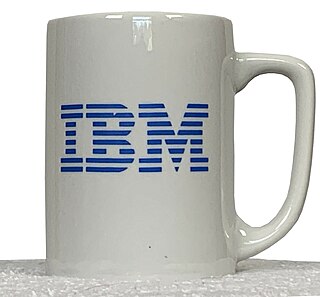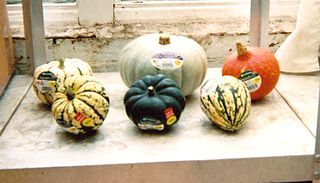Related Research Articles

A supermarket is a self-service shop offering a wide variety of food, beverages and household products, organized into sections. This kind of store is larger and has a wider selection than earlier grocery stores, but is smaller and more limited in the range of merchandise than a hypermarket or big-box market. In everyday U.S. usage, however, "grocery store" is often used to mean "supermarket".

Retail is the sale of goods and services to consumers, in contrast to wholesaling, which is sale to business or institutional customers. A retailer purchases goods in large quantities from manufacturers, directly or through a wholesaler, and then sells in smaller quantities to consumers for a profit. Retailers are the final link in the supply chain from producers to consumers.

A grocery store (AE), grocery shop (BE) or simply grocery is a foodservice retail store that primarily retails a general range of food products, which may be fresh or packaged. In everyday U.S. usage, however, "grocery store" is a synonym for supermarket, and is not used to refer to other types of stores that sell groceries. In the UK, shops that sell food are distinguished as grocers or grocery shops.

Distribution is the process of making a product or service available for the consumer or business user who needs it, and a distributor is a business involved in the distribution stage of the value chain. Distribution can be done directly by the producer or service provider or by using indirect channels with distributors or intermediaries. Distribution is one of the four elements of the marketing mix: the other three elements being product, pricing, and promotion.
Sales promotion is one of the elements of the promotional mix. The primary elements in the promotional mix are advertising, personal selling, direct marketing and publicity/public relations. Sales promotion uses both media and non-media marketing communications for a pre-determined, limited time to increase consumer demand, stimulate market demand or improve product availability. Examples include contests, coupons, freebies, loss leaders, point of purchase displays, premiums, prizes, product samples, and rebates.

Pricing is the process whereby a business sets the price at which it will sell its products and services, and may be part of the business's marketing plan. In setting prices, the business will take into account the price at which it could acquire the goods, the manufacturing cost, the marketplace, competition, market condition, brand, and quality of product.

In microeconomics, two goods are substitutes if the products could be used for the same purpose by the consumers. That is, a consumer perceives both goods as similar or comparable, so that having more of one good causes the consumer to desire less of the other good. Contrary to complementary goods and independent goods, substitute goods may replace each other in use due to changing economic conditions. An example of substitute goods is Coca-Cola and Pepsi; the interchangeable aspect of these goods is due to the similarity of the purpose they serve, i.e fulfilling customers' desire for a soft drink. These types of substitutes can be referred to as close substitutes.

Merchandising is any practice which contributes to the sale of products to a retail consumer. At a retail in-store level, merchandising refers to displaying products that are for sale in a creative way that entices customers to purchase more items or products.

In non-Asian countries, an Asian supermarket largely describes a category of grocery stores that focuses and stocks items and products imported from countries located in the Far East.

Planograms, also known as plano-grams, plan-o-grams, schematics, POGs or simply plans, are visual representations of a store's products or services on display. They are considered a tool for visual merchandising. According to the Merriam-Webster Dictionary, a planogram is "a schematic drawing or plan for displaying merchandise in a store so as to maximize sales." The effectiveness of the planogram can be measured by the sales volume generated from the specific area being diagrammed.

Once the strategic plan is in place, retail managers turn to the more managerial aspects of planning. A retail mix is devised for the purpose of coordinating day-to-day tactical decisions. The retail marketing mix typically consists of six broad decision layers including product decisions, place decisions, promotion, price, personnel and presentation. The retail mix is loosely based on the marketing mix, but has been expanded and modified in line with the unique needs of the retail context. A number of scholars have argued for an expanded marketing, mix with the inclusion of two new Ps, namely, Personnel and Presentation since these contribute to the customer's unique retail experience and are the principal basis for retail differentiation. Yet other scholars argue that the Retail Format should be included. The modified retail marketing mix that is most commonly cited in textbooks is often called the 6 Ps of retailing.

Visual merchandising is the practice in the retail industry of optimizing the presentation of products and services to better highlight their features and benefits. The purpose of such visual merchandising is to attract, engage, and motivate the customer towards making a purchase.

Omni Superstore was a chain of supermarkets in the Chicago area and was owned by Dominick's. In 1997, Dominick's phased out Omni and converted the stores into Dominick's because the concept was not generating enough revenue compared to other Dominick's stores.

Food marketing brings together the food producer and the consumer through a chain of marketing activities.
The following outline is provided as an overview of and topical guide to marketing:
A touchpoint can be defined as any way consumers can interact with a business organization, whether it be person-to-person, through a website, an app or any form of communication. When consumers come in contact with these touchpoints it gives them the opportunity to compare their prior perceptions of the business and form an opinion.
A marketing channel consists of the people, organizations, and activities necessary to transfer the ownership of goods from the point of production to the point of consumption. It is the way products get to the end-user, the consumer; and is also known as a distribution channel. A marketing channel is a useful tool for management, and is crucial to creating an effective and well-planned marketing strategy.
Test and learn is a set of practices followed by retailers, banks and other consumer-focused companies to test ideas in a small number of locations or customers to predict impact. The process is often designed to answer three questions about any tested program before rollout:
- What impact will the program have on key performance indicators if executed across the network or customer base?
- Will the program have a larger impact on some stores/customers than others?
- Which components of the idea are actually working?

Shelf-ready packaging (SRP) and retail-ready packaging (RRP) refers to the packaging of a product so that it is delivered to a retailer in packaging which is optimized for efficient stocking and sale.
The retail format influences the consumer's store choice and addresses the consumer's expectations. At its most basic level, a retail format is a simple marketplace, that is; a location where goods and services are exchanged. In some parts of the world, the retail sector is still dominated by small family-run stores, but large retail chains are increasingly dominating the sector, because they can exert considerable buying power and pass on the savings in the form of lower prices. Many of these large retail chains also produce their own private labels which compete alongside manufacturer brands. Considerable consolidation of retail stores has changed the retail landscape, transferring power away from wholesalers and into the hands of the large retail chains.
References
- ↑ "What is Cross Merchandising? (with pictures)". wiseGEEK. Retrieved 2015-11-04.
- ↑ "The Art of Cross-Merchandising | Albert's Organics". albertsorganics.com. Retrieved 2015-11-04.
- ↑ "merchandising | myRetailPOV". myretailpov.com. Retrieved 2015-11-04.
- ↑ "Amazon.co.uk Associates Central". affiliate-program.amazon.co.uk. Retrieved 2015-11-04.
- ↑ "Perfect pairings". Macfadden Grocery Headquarters, LLC. Archived from the original on 2015-03-26. Retrieved 2015-11-04.
- ↑ "Beef Fast Facts" (PDF).
- ↑ Coughlan, Anne T. (1987). "Distribution channel choice in a market with complementary goods". International Journal of Research in Marketing. 4 (2): 85–97. doi:10.1016/0167-8116(87)90001-2.
- ↑ Anderton, Paula (June 2005). "Branded Brands - Cross-Merchandising at the Next Level". Hardware & Home Centre Magazine. Vol. 29, no. 4. pp. 6–7. ProQuest 198908686.
- ↑ "Sign In". jss.sagepub.com. Retrieved 2015-11-04.